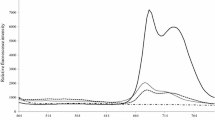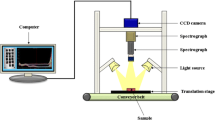Abstract
Consumption of fresh produce has been linked to multiple outbreaks of serious foodborne illnesses over the past two decades, and the popularity growth of ready-to-eat fruit and vegetable products may be related to the increased incidence of produce-related outbreaks. Because the sources of the pathogenic microorganisms most frequently involved in these outbreaks, E. coli O157: H7 and Salmonella, have been attributed primarily to animal fecal matter, research examining routes of fecal contamination and developing methods to prevent them have been areas of recent emphasis. This investigation used non-destructive hyperspectral fluorescence imaging to evaluate relatively simple spectral classification algorithms—using single wavebands or two-band ratios—for detecting animal feces contamination on leafy greens. In particular, this study sought to detect and discriminate between feces contamination from four animal species on romaine lettuce leaves. Single fluorescence wavebands found to be effective for discriminating feces from dairy cattle, pig, chicken, and sheep were F641 nm, F505 nm, F633 nm, and F645 nm, respectively. A two-band ratio in the range of F664 ± 4 nm/F694 ± 2 nm was shown to have a detection accuracy of over 93% for undiluted feces and 1:20 and 1:50 fecal dilutions for three of the four fecal species. The spectral bands identified in this hyperspectral imaging study can be implemented for use in a relatively simple portable hand-held imaging device for on-site safety evaluation of produce in the field.





Similar content being viewed by others
References
Bark, K. M., Yang, J. I., Lee, H. S., Lee, J. B., Park, C. H., & Park, H. R. (2010). Physicochemical properties of protoporphyrin IX by metal ions in acetonitrile-water mixture solution. Bulletin of the Korean Chemical Society, 31(6), 1633–1637. https://doi.org/10.5012/bkcs.2010.31.6.1633.
Buck, J. W., & Pathology, P. (2003). Recent trends in microbiological safety of fruits and vegetables plant health progress plant health progress. Plant Management Network. https://doi.org/10.1094/PHP-2003-0121-01-RV.
Casini, S., Fossi, M. C., Leonzio, C., & Renzoni, A. (2003). Review: porphyrins as biomarkers for hazard assessment of bird populations: destructive and non-destructive use. Ecotoxicology, 12(1–4), 297–305. https://doi.org/10.1023/A:1022519214505.
Cho, H., Lee, H., Kim, S., Kim, D., Lefcourt, A., Chan, D., Chung, S., & Kim, M. (2016). Potential application of fluorescence imaging for assessing fecal contamination of soil and compost maturity. Applied Sciences, 6(9), 243. https://doi.org/10.3390/app6090243.
Cordón, G. B., & Lagorio, M. G. (2007). Optical properties of the adaxial and abaxial faces of leaves. Chlorophyll fluorescence, absorption and scattering coefficients. Photochemical & Photobiological Sciences : Official Journal of the European Photochemistry Association and the European Society for Photobiology, 6(8), 873–882. https://doi.org/10.1039/b617685b.
Everard, C. D., Kim, M. S., & Lee, H. (2014). A comparison of hyperspectral reflectance and fluorescence imaging techniques for detection of contaminants on spinach leaves. Journal of Food Engineering, 143, 139–145. https://doi.org/10.1016/j.jfoodeng.2014.06.042.
Hoelzer, K., Pouillot, R., Egan, K., & Dennis, S. (2012). Produce consumption in the United States: an analysis of consumption frequencies, serving sizes, processing forms, and high-consuming population subgroups for microbial risk assessments. Journal of Food Protection, 75(2), 328–340. https://doi.org/10.4315/0362-028X.JFP-11-313.
Jiménez-Monreal, A. M., García-Diz, L., Martínez-Tomé, M., Mariscal, M., & Murcia, M. A. (2009). Influence of cooking methods on antioxidant activity of vegetables. Journal of Food Science, 74(3), 97–103. https://doi.org/10.1111/j.1750-3841.2009.01091.x.
Jones, C. L. (2015). HHS Public Access, 33(4), 395–401. doi:https://doi.org/10.1038/nbt.3121.ChIP-nexus
Kang, S., Lee, K., Son, J., & Kim, M. S. (2011). Detection of fecal contamination on leafy greens by hyperspectral imaging. Procedia Food Science, 1, 953–959. https://doi.org/10.1016/j.profoo.2011.09.143.
Kearney, J. (2010). Food consumption trends and drivers. Philosophical Transactions of the Royal Society B: Biological Sciences, 365(1554), 2793–2807. https://doi.org/10.1098/rstb.2010.0149.
Kim, M. S., Lefcourt, A. M., Chao, K., Chen, Y. R., Kim, I., & Chan, D. E. (2002). Multispectral detection of fecal contamination on apples based on hyperspectral imagery: Part I. Application of visible and near-infrared refrectance imaging. Transactions of ASAE, 45(6), 2027–2037. https://doi.org/10.13031/2013.11414.
Kim, M. S., Lefcourt, A. M., & Chen, Y.-R. (2003). Optimal fluorescence excitation and emission bands for detection of fecal contamination. Journal of Food Protection, 66(7), 1198–1207. http://www.ncbi.nlm.nih.gov/pubmed/12870753. https://doi.org/10.4315/0362-028X-66.7.1198.
Lang, M., Stober, F., & Lichtenthaler, H. K. (1991). Fluorescence emission spectra of plant leaves and plant constituents. Radiation and Environmental Biophysics, 30(4), 333–347. https://doi.org/10.1007/BF01210517.
Lee, H., Everard, C. D., Kang, S., Cho, B. K., Chao, K., Chan, D. E., & Kim, M. S. (2014a). Multispectral fluorescence imaging for detection of bovine faeces on Romaine lettuce and baby spinach leaves. Biosystems Engineering, 127, 125–134. https://doi.org/10.1016/j.biosystemseng.2014.08.019.
Lee, W. H., Kim, M. S., Lee, H., Delwiche, S. R., Bae, H., Kim, D. Y., & Cho, B. K. (2014b). Hyperspectral near-infrared imaging for the detection of physical damages of pear. Journal of Food Engineering, 130, 1–7. https://doi.org/10.1016/j.jfoodeng.2013.12.032.
Liew, O. W., Chong, P. C. J., Li, B., & Asundi, A. K. (2008). Signature optical cues: emerging technologies for monitoring plant health. Sensors, 8(5), 3205–3239. https://doi.org/10.3390/s8053205.
Lin, D. L., He, L. F., & Li, Y. Q. (2004). Rapid and simultaneous determination of coproporphyrin and protoporphyrin in feces by derivative matrix isopotential synchronous fluorescence spectrometry. Clinical Chemistry, 50(10), 1797–1803. https://doi.org/10.1373/clinchem.2004.034223.
List of Selected Multistate Foodborne Outbreak Investigations. (2017). Centers for Disease Control and Prevention. https://www.cdc.gov/foodsafety/outbreaks/multistate-outbreaks/outbreaks-list.html.
Lynch, M. F., Tauxe, R. V., & Hedberg, C. W. (2009). The growing burden of foodborne outbreaks due to contaminated fresh produce: risks and opportunities. Epidemiology and Infection, 137(3), 307–315. https://doi.org/10.1017/S0950268808001969.
Ma, L., & Dolphin, D. (1999). {T}he metabolites of {D}dieta chlorophylls. Phytochemistry, 50(137), 195–202. https://doi.org/10.1016/S0031-9422(98)00584-6.
Mateo, R., Castells, G., Green, A. J., Godoy, C., & Cristòfol, C. (2004). Determination of porphyrins and biliverdin in bile and excreta of birds by a single liquid chromatography-ultraviolet detection analysis. Journal of Chromatography B: Analytical Technologies in the Biomedical and Life Sciences, 810(2), 305–311. https://doi.org/10.1016/j.jchromb.2004.08.019.
Sheila Merriweather; Tami, Craig Cloyd; Cerise, Robinsos; Diane, G. (2015). 2011–2014 produce related outbreaks and illnesses (Vol. 12). http://www.regulations.gov/document?D=FDA-2014-N-2244-0382.
Mollazade, K., Omid, M., Tab, F. A., & Mohtasebi, S. S. (2012). Principles and applications of light backscattering imaging in quality evaluation of agro-food products: a review. Food and Bioprocess Technology, 5(5), 1465–1485. https://doi.org/10.1007/s11947-012-0821-x.
Olaimat, A. N., & Holley, R. A. (2012). Factors influencing the microbial safety of fresh produce: a review. Food Microbiology, 32(1), 1–19. https://doi.org/10.1016/j.fm.2012.04.016.
Rollakanti, K. R., Kanick, S. C., Davis, S. C., Pogue, B. W., & Maytin, E. V. (2013). Techniques for fluorescence detection of protoporphyrin IX in skin cancers associated with photodynamic therapy. Photonics and Lasers in Medicine, 2(4), 287–303. https://doi.org/10.1515/plm-2013-0030.
Scallan, E., Hoekstra, R. M., Angulo, F. J., Tauxe, R. V., Widdowson, M. A., Roy, S. L., Jones, J. L., & Griffin, P. M. (2011). Foodborne illness acquired in the United States—major pathogens. Emerging Infectious Diseases, 17(1), 7–15. https://doi.org/10.3201/eid1701.P11101.
Schultze, M. O. (1942). The isolation of protoporphyrin IX from feces of normal and anemic rats. The Journal of Biological Chemistry, 142, 89–96. http://www.jbc.org/142/1/189/89.
Seybold, P. G., & Gouterman, M. (1969). Porphyrins. Journal of Molecular Spectroscopy, 31(1–13), 1–13. https://doi.org/10.1016/0022-2852(69)90335-X.
Slavin, J., & Lloyd, B. (2012). Health benefits of fruits and vegetables. Advances in Nutrition, 3(4), 506–516. https://doi.org/10.3945/an.112.002154.506.
Teena, M., Manickavasagan, A., Mothershaw, A., El Hadi, S., & Jayas, D. S. (2013). Potential of machine vision techniques for detecting fecal and microbial contamination of food products: a review. Food and Bioprocess Technology, 6(7), 1621–1634. https://doi.org/10.1007/s11947-013-1079-7.
U.S. Department of Health & Human Services. (2015). Part III Department of Health and Human Services. Federal Register, 80(200), 1–195 http://webapps.dol.gov/federalregister/PdfDisplay.aspx?DocId=26927.
Valipour, M. (2014). Application of new mass transfer formulae for computation of evapotranspiration. Journal of Applied Water Engineering and Research, 2(1), 33–46. https://doi.org/10.1080/23249676.2014.923790.
Valipour, M. (2017). Global experience on irrigation management under different scenarios. Journal of Water and Land Development, 32(1), 95–102. https://doi.org/10.1515/jwld-2017-0011.
Carol D’Lima, K Vierk. (2011). Produce related outbreaks and illnesses. http://www.regulations.gov/document?D=FDA-2011-N-0921-18884.
Yang, C.-C., Jun, W., Kim, M. S., Chao, K., Kang, S., Chan, D. E., & Lefcourt, A. (2010). Classification of fecal contamination on leafy greens by hyperspectral imaging. SPIE, Sensing for Agriculture and food Auality and Safety, 7676. https://doi.org/10.1117/12.851069.
Zhang, R., Ying, Y., Rao, X., & Li, J. (2012). Quality and safety assessment of food and agricultural products by hyperspectral fluorescence imaging. Journal of the Science of Food and Agriculture, 92(12), 2397–2408. https://doi.org/10.1002/jsfa.5702.
Acknowledgments
The authors would like to thank all of Mónica Santín-Durán for providing animal fecal samples and Diane E. Chane for insightfully reviewing the manuscript of Environmental Microbial and Food Safety Lab, Beltsville Agricultural Research Center, Agricultural Research Service, US Department.
Funding
This research was partially supported by the Cooperative Agreement between the Experiment and Research Institute, National Agricultural Products Quality Management Service, Republic of Korea and Agricultural Research Service, USDA, USA.
Author information
Authors and Affiliations
Corresponding author
Rights and permissions
About this article
Cite this article
Cho, H., Kim, M.S., Kim, S. et al. Hyperspectral Determination of Fluorescence Wavebands for Multispectral Imaging Detection of Multiple Animal Fecal Species Contaminations on Romaine Lettuce. Food Bioprocess Technol 11, 774–784 (2018). https://doi.org/10.1007/s11947-017-2032-y
Received:
Accepted:
Published:
Issue Date:
DOI: https://doi.org/10.1007/s11947-017-2032-y




